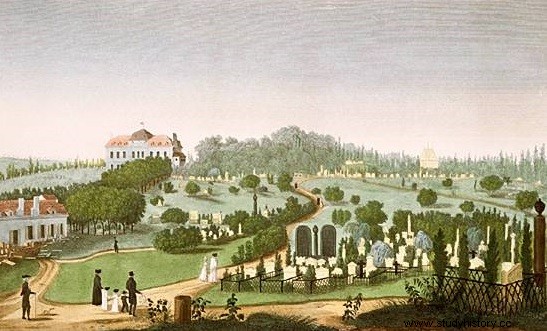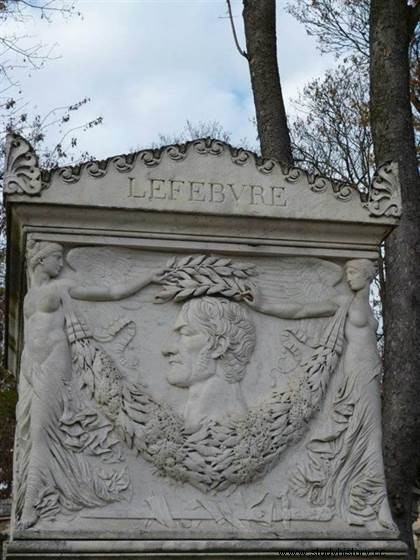 The Père-Lachaise Cemetery is a cemetery located in the 20th arrondissement, in Paris, renowned for its many graves of famous people. It takes its name from the property of the Jesuits, acquired in 1626 and baptized Mont-Louis, where the Reverend Father François d'Aix de la Chaize, confessor of Louis XIV, had made his residence. Alexandre Théodore Brongniart, architect of the Paris Stock Exchange, converted it in 1807 into a wooded area, animated by winding paths. Today, it allows visitors to travel back in time along one of the largest green spaces in the city.
The Père-Lachaise Cemetery is a cemetery located in the 20th arrondissement, in Paris, renowned for its many graves of famous people. It takes its name from the property of the Jesuits, acquired in 1626 and baptized Mont-Louis, where the Reverend Father François d'Aix de la Chaize, confessor of Louis XIV, had made his residence. Alexandre Théodore Brongniart, architect of the Paris Stock Exchange, converted it in 1807 into a wooded area, animated by winding paths. Today, it allows visitors to travel back in time along one of the largest green spaces in the city.
Père-lachaise cemetery, place of great names and bloody history
Which Parisian district has the best chance of meeting celebrities? In St-Germain-des-près, the literary? In the eccentric Marais? In the depths of the 17th century bourgeois perhaps? Or in the cozy lounges near Place de l'Etoile? Nope:at the Père Lachaise cemetery, in the popular 20th arrondissement of the capital. All of Paris has been meeting and resting there for ages, attracting up to 2 million visitors a year. Of course, having fun finding the final resting place of Chopin (1810-1849), Alfred de Musset (1810-1857), Colette (1873-1954) or even Jim Morrisson (1943-1971) is entertaining, moving for those who want to pay homage to them but, who also remembers the dramas that took place here?
 In 1814 the students of the military schools of Polytechnique and Alfort took refuge in the cemetery facing the advance Russian troops and are massacred on the spot, falling on the ground in the center of this 'garden of the dead'. It was especially in 1871 during the episode of the Commune that the eastern cemetery (its former name) stands out sadly. The last battles between Versailles and Federates took place there at the end of the “Bloody Week”. The Federated prisoners are massacred by Versailles troops. After the fighting, 148 federal prisoners are brought in and shot against the wall that now bears their name. Since then, this place has become a place of memory for the parties that claim to be part of the heritage of the Commune.
In 1814 the students of the military schools of Polytechnique and Alfort took refuge in the cemetery facing the advance Russian troops and are massacred on the spot, falling on the ground in the center of this 'garden of the dead'. It was especially in 1871 during the episode of the Commune that the eastern cemetery (its former name) stands out sadly. The last battles between Versailles and Federates took place there at the end of the “Bloody Week”. The Federated prisoners are massacred by Versailles troops. After the fighting, 148 federal prisoners are brought in and shot against the wall that now bears their name. Since then, this place has become a place of memory for the parties that claim to be part of the heritage of the Commune.
From sinister graveyard to ultimate snobbery
 Before becoming the largest cemetery in Paris, the land belonged to the Jesuits, including Father La Chaise ( confessor of Louis XIV). Faced with the insalubrity of intramural cemeteries, it was decided to build new necropolises. The Eastern cemetery thus officially opened its gates in 1804. In the first years, 80% of the burials consisted of mass graves:the price of the concessions was high and the 'success' with the Parisians was not really there. A bright shot then from those in charge:bringing in the burials of Molière (1622-1673), Lafontaine (1621-1695) then those of the mythical cursed lovers of the Middle Ages:Héloïse and Abélard (he, a sensual theologian, will be castrated for having loved beauty and the two will be separated until death before... being reunited for eternity).
Before becoming the largest cemetery in Paris, the land belonged to the Jesuits, including Father La Chaise ( confessor of Louis XIV). Faced with the insalubrity of intramural cemeteries, it was decided to build new necropolises. The Eastern cemetery thus officially opened its gates in 1804. In the first years, 80% of the burials consisted of mass graves:the price of the concessions was high and the 'success' with the Parisians was not really there. A bright shot then from those in charge:bringing in the burials of Molière (1622-1673), Lafontaine (1621-1695) then those of the mythical cursed lovers of the Middle Ages:Héloïse and Abélard (he, a sensual theologian, will be castrated for having loved beauty and the two will be separated until death before... being reunited for eternity).
In this romantic era, the publicity stunt paid off. The townspeople came in large numbers to pay homage and soon dreamed only of being buried, when the time came, beside these geniuses of the pen and the heart. Ah, the vanity... In 1830:already 30,000 tombs installed. The park is expanding, reaching today 44 hectares (and 69,000 tombs). The cemetery will soon resemble, in the mid-19th century, a real Who's Who? of the time. Many politicians will come to rest there, too. Félix Faure (1841-1899), Baron Hausmann (1809-1891)... Their burials will often give rise to subtle demonstrations of force, in these times when demonstrations were strictly controlled.
True funeral masterpieces
In the 19th century, equality in the face of death became a very...theoretical notion. The natural snobbery of some helping, the cemetery is adorned with absolutely magnificent tombs, stelae, bronze, marble and wrought iron sculptures (moreover, all the funerary monuments dating from before 1900 are listed). Crazy amounts of money are spent by some Narcissus to build eternal homes to match their ego.
Thus, this hallucinating column of about twenty meters containing the four favorite objects of the deceased (with a name long forgotten). There, this disappeared represented in statue riding, conquering, a proud wild lion. Or this other in bronze who raises a clenched fist towards the sky, seeming to curse the heavens for not having made him immortal. All the aristocracy of the time, that of the Restoration, the July Monarchy as well as that of the Second Empire rub shoulders and their particle names are still visible, on the pediments of their family prides half-covered by ivy. In addition, there are twelve listed historical monuments:portal and chapel of Godde, monument to the dead of Bartholomé, Héloïse and Abélard, Molière and La Fontaine, Delille, the Dragon, Mur des Fédérés, Cartellier, O. Wilde, chapel Georges Guët.
Père-Lachaise cemetery, a place for a walk
 Walking through these alleys, rich in 5300 trees (some of which are 150 years old), wild grasses, and always peaceful (the place does not encourage excesses, even the children remain calm), like a strange impression of touching History with your finger. Human nature too, through the ridiculously pretentious side of certain burials. As long as the weather is gloomy, that some of the many cats patrolling around cross our path and, we quicken our pace, suddenly superstitious, in front of the crematorium (the first in France then). Back on another path, turn your head and stumble upon the last scene of Sarah Bernhardt (1844-1923). A very simple tomb for the one who lived only through extravagance. Thoughtful smile.
Walking through these alleys, rich in 5300 trees (some of which are 150 years old), wild grasses, and always peaceful (the place does not encourage excesses, even the children remain calm), like a strange impression of touching History with your finger. Human nature too, through the ridiculously pretentious side of certain burials. As long as the weather is gloomy, that some of the many cats patrolling around cross our path and, we quicken our pace, suddenly superstitious, in front of the crematorium (the first in France then). Back on another path, turn your head and stumble upon the last scene of Sarah Bernhardt (1844-1923). A very simple tomb for the one who lived only through extravagance. Thoughtful smile.
A little further on, the recumbent statue of the murdered journalist Victor Noir (1848-1870). Her prominent crotch is glossy:a strange pagan tradition has it that some come and rub themselves there in the hope of regaining fertility or virility. Cheer up heartily. Pursue your way at random in this beautiful garden, with a sweet welcome melancholy as your intimate companion. Without knowing what still awaits us at the crossroads of these mysterious paths, in this place of death which, finally, breathes life. And History.
- Frédéric L'Helgoualch is the author of 'Deci-Delà (since nothing happens as planned)' at ed. from the Net.
To go further
- The Père-Lachaise Cemetery, by Jose de Valverde. Editions Ouest-France, 2017.
- Père-Lachaise:In the heart of the Paris of the living and the dead, by Christian Charlet. Gallimard, 2003.
